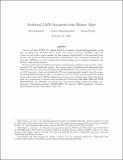Statistical zapr arguments from bilinear maps
Author(s)
Lombardi, Alex; Vaikuntanathan, Vinod; Wichs, Daniel
DownloadAccepted version (515.2Kb)
Open Access Policy
Open Access Policy
Creative Commons Attribution-Noncommercial-Share Alike
Terms of use
Metadata
Show full item recordAbstract
© International Association for Cryptologic Research 2020. Dwork and Naor (FOCS ’00) defined ZAPs as 2-message witness-indistinguishable proofs that are public-coin. We relax this to ZAPs with private randomness (ZAPRs), where the verifier can use private coins to sample the first message (independently of the statement being proved), but the proof must remain publicly verifiable given only the protocol transcript. In particular, ZAPRs are reusable, meaning that the first message can be reused for multiple proofs without compromising security. Known constructions of ZAPs from trapdoor permutations or bilinear maps are only computationally WI (and statistically sound). Two recent results of Badrinarayanan-Fernando-Jain-Khurana-Sahai and Goyal-Jain-Jin-Malavolta [EUROCRYPT ’20] construct the first statistical ZAP arguments, which are statistically WI (and computationally sound), from the quasi-polynomial LWE assumption. Here, we construct statistical ZAPR arguments from the quasi-polynomial decision-linear (DLIN) assumption on groups with a bilinear map. Our construction relies on a combination of several tools, including the Groth-Ostrovsky-Sahai NIZK and NIWI [EUROCRYPT ’06, CRYPTO ’06, JACM ’12], “sometimes-binding statistically hiding commitments” [Kalai-Khurana-Sahai, EUROCRYPT ’18] and the “MPC-in-the-head” technique [Ishai-Kushilevitz-Ostrovsky-Sahai, STOC ’07].
Date issued
2020-02Department
Massachusetts Institute of Technology. Department of Electrical Engineering and Computer ScienceJournal
Lecture Notes in Computer Science (including subseries Lecture Notes in Artificial Intelligence and Lecture Notes in Bioinformatics)
Publisher
Springer International Publishing
Citation
2020. "Statistical zapr arguments from bilinear maps." Lecture Notes in Computer Science (including subseries Lecture Notes in Artificial Intelligence and Lecture Notes in Bioinformatics), 12107 LNCS.
Version: Author's final manuscript